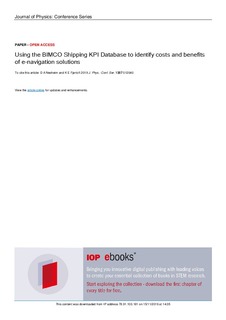| dc.contributor.author | Nesheim, Dag Atle | |
| dc.contributor.author | Fjørtoft, Kay Endre | |
| dc.date.accessioned | 2019-11-18T13:16:36Z | |
| dc.date.available | 2019-11-18T13:16:36Z | |
| dc.date.created | 2019-11-15T09:48:14Z | |
| dc.date.issued | 2019-11 | |
| dc.identifier.issn | 1742-6588 | |
| dc.identifier.uri | http://hdl.handle.net/11250/2629083 | |
| dc.description.abstract | In the RCN-funded research project SESAME Solution II, funded by the Norwegian Research Council under the MarOff programme, a key aspect is to develop a cost benefit assessment framework. This framework will be used to assess the solutions related to enavigation and automatic reporting, to be developed by the project. Some benefits are only visible on a larger or aggregated scale. This is particularly true for benefits which concern the reduction of unwanted incidents (e.g. accidents, deficiencies and detentions). Instead of focusing on case by case, historical trending on industrial or segment level provides a better picture of the actual benefit of certain solutions and measures. For this we need access to trustworthy sources. In the SESAME Solution II project, we have gained access to BIMCO's Shipping KPI Standard database. BIMCO is the world’s largest international shipping association, with around 2100 members. Membership includes shipowners, operators, managers, brokers and agents. This database contains performance data related to ship management from 2011 with thousands of ships reporting KPIs (Key Performance Indicators on a quarterly basis. The database also allows for selections on the basis of ship type, trade, etc. This paper explores the challenges and opportunities related to such use of statistics and aggregations when assessing the potential benefits (and costs) related to e-navigation and automatic reporting. Such challenges include the mapping of KPIs to the implementation of specific solutions/measures. As an example, aggregated KPIs may show the effect of certain IMO regulations such as the IMO DCS (Data Collection System: Monitoring, validating and reporting fuel consumption and CO2-emissions from international shipping). Other Challenges include proving correlation as well as an overview of external factors which may skew the conclusions. The suggested approach will prove adaptable to similar sources of data such as THETIS, APCIS and others. | nb_NO |
| dc.language.iso | eng | nb_NO |
| dc.rights | Navngivelse 4.0 Internasjonal | * |
| dc.rights.uri | http://creativecommons.org/licenses/by/4.0/deed.no | * |
| dc.title | Using the BIMCO Shipping KPI Database to identify costs and benefits of e-navigation solutions | nb_NO |
| dc.type | Journal article | nb_NO |
| dc.type | Peer reviewed | nb_NO |
| dc.description.version | publishedVersion | nb_NO |
| dc.rights.holder | © The Authors 2019. Content from this work may be used under the terms of the Creative Commons Attribution 3.0 licence. Any further distribution of this work must maintain attribution to the author(s) and the title of the work, journal citation and DOI. Published under licence by IOP Publishing Ltd | nb_NO |
| dc.source.journal | Journal of Physics: Conference Series | nb_NO |
| dc.identifier.doi | 10.1088/1742-6596/1357/1/012040 | |
| dc.identifier.cristin | 1747874 | |
| cristin.unitcode | 7566,7,0,0 | |
| cristin.unitname | Energi og transport | |
| cristin.ispublished | true | |
| cristin.fulltext | original | |
| cristin.qualitycode | 1 | |

